Overview
Inventory is classified as a current asset on a business’s balance sheet, playing a crucial role in revenue generation and overall financial performance. The article emphasizes that effective inventory management is essential for balancing stock levels to meet customer demand while minimizing holding costs, which directly impacts cash flow and profitability.
Introduction
In the dynamic landscape of modern business, inventory management emerges as a critical component that can make or break a company’s success. As organizations strive to balance customer demand with operational efficiency, understanding the nuances of inventory as a valuable asset becomes essential. From the various types of inventory to the challenges posed by supply chain disruptions, businesses must navigate a complex web of strategies to optimize their stock levels.
With a growing emphasis on data-driven solutions and innovative practices, the way companies approach inventory management is evolving rapidly. This article delves into the significance of effective inventory management, exploring:
- Best practices
- Common challenges
- The transformative potential of technology in enhancing operational performance.
Defining Inventory: A Key Business Asset
The classification of inventory as a current asset on the balance sheet raises the question: is inventory an asset that includes the goods and materials an organization holds for resale or production purposes, anticipating conversion into cash within a year? The significance of stock extends beyond its intrinsic value; it plays a pivotal role in revenue generation. For businesses, understanding if stock is inventory an asset is essential, as it has a direct bearing on cash flow, profitability, and operational efficiency.
Companies must strike a delicate balance between maintaining enough stock to satisfy customer demand and minimizing associated holding costs. This balance is crucial, as excessive stock can strain cash flow, while insufficient levels may lead to missed sales opportunities, ultimately affecting overall financial performance. Significantly, recent trends suggest that the Small & Medium Enterprises (SMEs) sector is ready for swift expansion in resource handling solutions, promoting a more strategic method to asset oversight and operational success.
As stated by Oliver Munro, global warehousing property expenses increased by 10.1% in 2023, highlighting the financial consequences of efficient stock control. Furthermore, the Middle East & Africa is anticipated to record the second-highest growth rate in the global market during the forecast period, emphasizing the rising significance of stock control solutions. Furthermore, a case study on logistics visibility reveals that 79% of chain leaders utilize dashboards for visibility, with real-time tracking identified as a solution for visibility issues, yet only a quarter of leaders currently use it.
This demonstrates the practical use of stock control techniques and the advantages of improving operational efficiency.
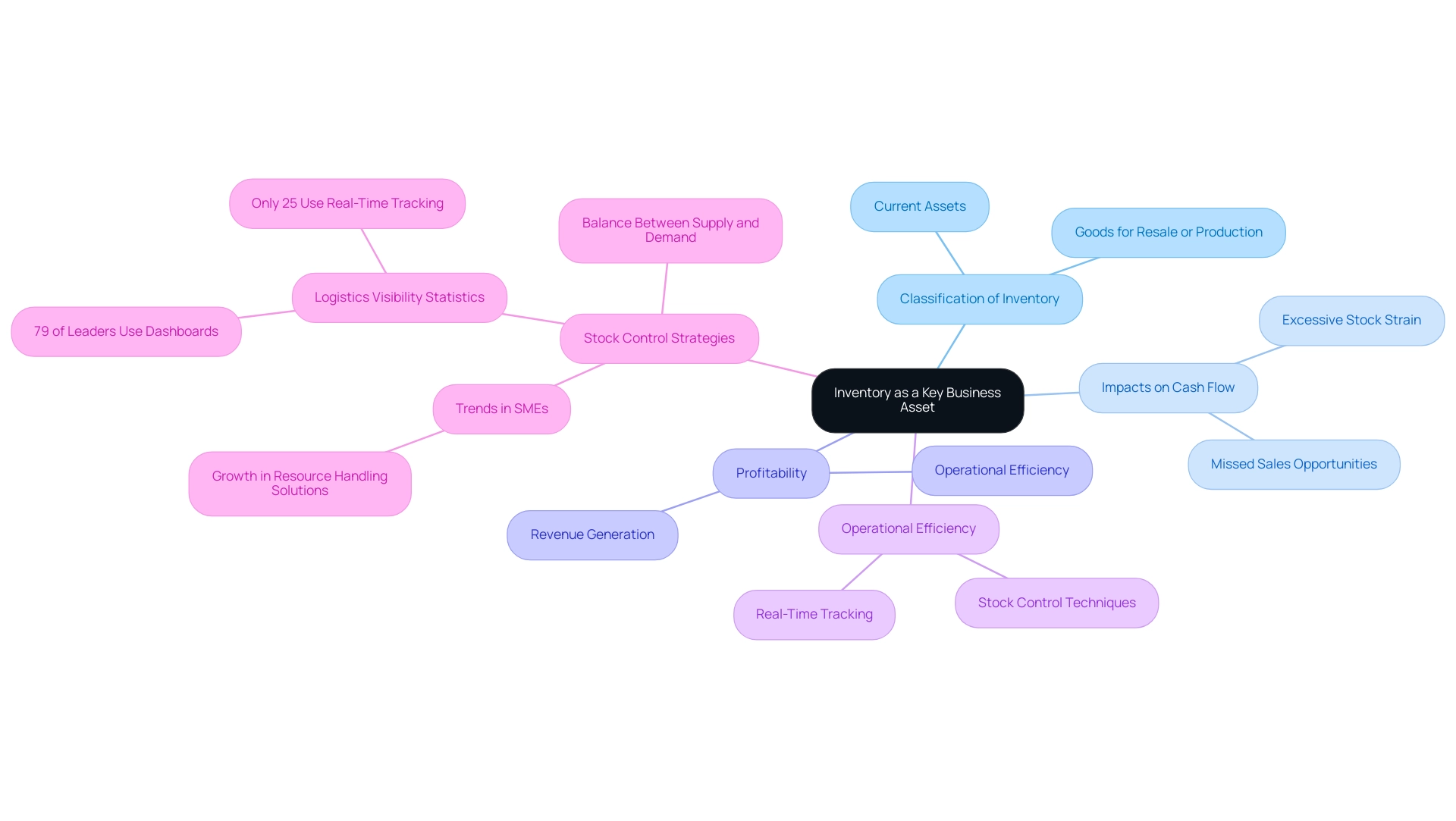
Types of Inventory: Understanding the Different Categories
Efficient stock control is essential for small enterprises, including various specific categories:
- Raw materials
- Work-in-progress (WIP)
- Finished products
- Maintenance, repair, and operations (MRO) resources
Raw materials serve as the foundational inputs for production processes, while WIP includes items currently being manufactured, reflecting the transition from raw materials to finished products. Finished goods represent completed products that are ready for sale, directly impacting sales performance and customer satisfaction.
MRO supplies, though essential for production, do not become part of the final product; they include tools and maintenance items necessary for operational continuity. Each category of stock has distinct implications for oversight, especially concerning cash flow, storage needs, and operational effectiveness. Comprehending these distinctions is essential for businesses to optimize stock strategies and enhance overall performance.
As FounderJar notes, ‘Only 22% of organizations have a proactive supply chain network,’ emphasizing the necessity for strategic stock management. Additionally, with the market projected to grow at a CAGR of 9.6% from 2025 to 2032, utilizing cloud-based management software can significantly enhance transparency and support strategic decision-making. This is particularly pertinent as the complexity of integrating stock across multiple channels increases.
Additionally, the case study named ‘A Second Trump Administration and U.S. Manufacturing: Potential Impact’ demonstrates how the changing manufacturing environment necessitates adaptability, creativity, and strategic thought, highlighting the significance of efficient stock control for small enterprises.
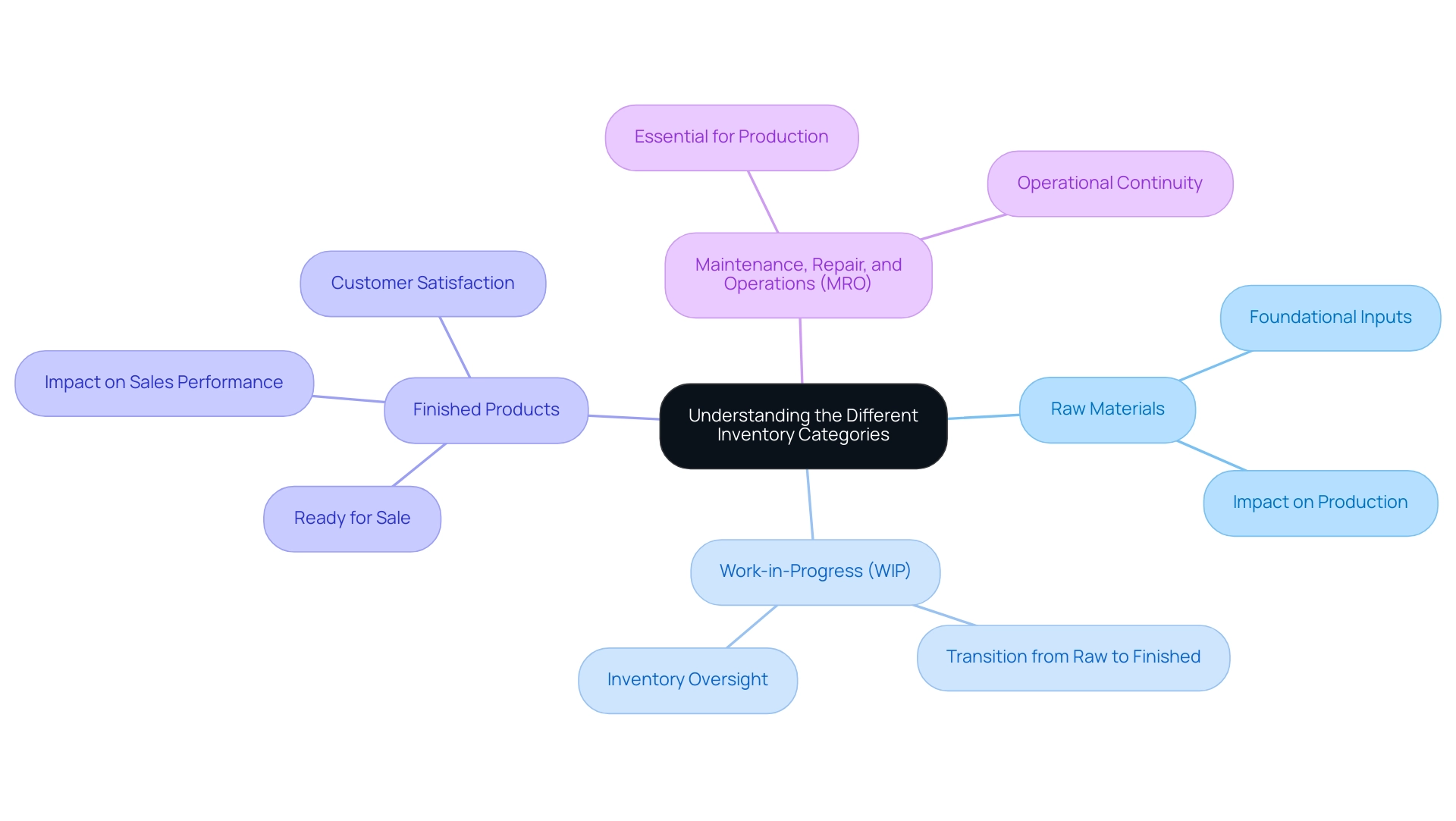
The Importance of Effective Inventory Management
Efficient stock control is essential for small enterprises to evaluate if inventory is inventory an asset, while also upholding ideal stock quantities, lowering expenses, and enhancing sales prospects. Recent data indicates that 42% of small businesses grapple with overstocking, and notably, 24% are overstocked and need to cancel surplus orders, underscoring the widespread nature of this issue. Implementing robust stock management practices can significantly mitigate the risks associated with stockouts and excess stock, prompting the inquiry of whether inventory is inventory an asset, as these issues are notorious for leading to lost sales and increased holding costs.
Techniques such as just-in-time (JIT) stock management, which focuses on receiving goods only as they are needed in the production process, demand forecasting, and turnover analysis are essential. These strategies ensure that is inventory an asset by guaranteeing the right products are available precisely when needed, thereby enhancing operational efficiency. Furthermore, effective stock management practices contribute to enhanced customer satisfaction by ensuring timely product delivery.
Colleen, a Marketing Specialist at Meteor Space, emphasizes the value of informed strategies, stating,
With extensive industry experience, I focus on delivering informative and insightful posts.
This specialist viewpoint emphasizes that addressing stock challenges, particularly the question of whether is inventory an asset, is not just about oversight but is essential to an organization’s overall success. The continuing battle with surplus stock is further demonstrated by the fact that 51% of small enterprises cite minimum order quantities (MOQs) as a major obstacle, complicating their stock oversight efforts.
The case study titled ‘Balancing the Over-Under’ indicates that while wholesale and manufacturing SMBs manage stockouts effectively, retailers face rising lost sales due to fluctuating consumer demand, highlighting the varied challenges different types of enterprises encounter in maintaining effective stock management.
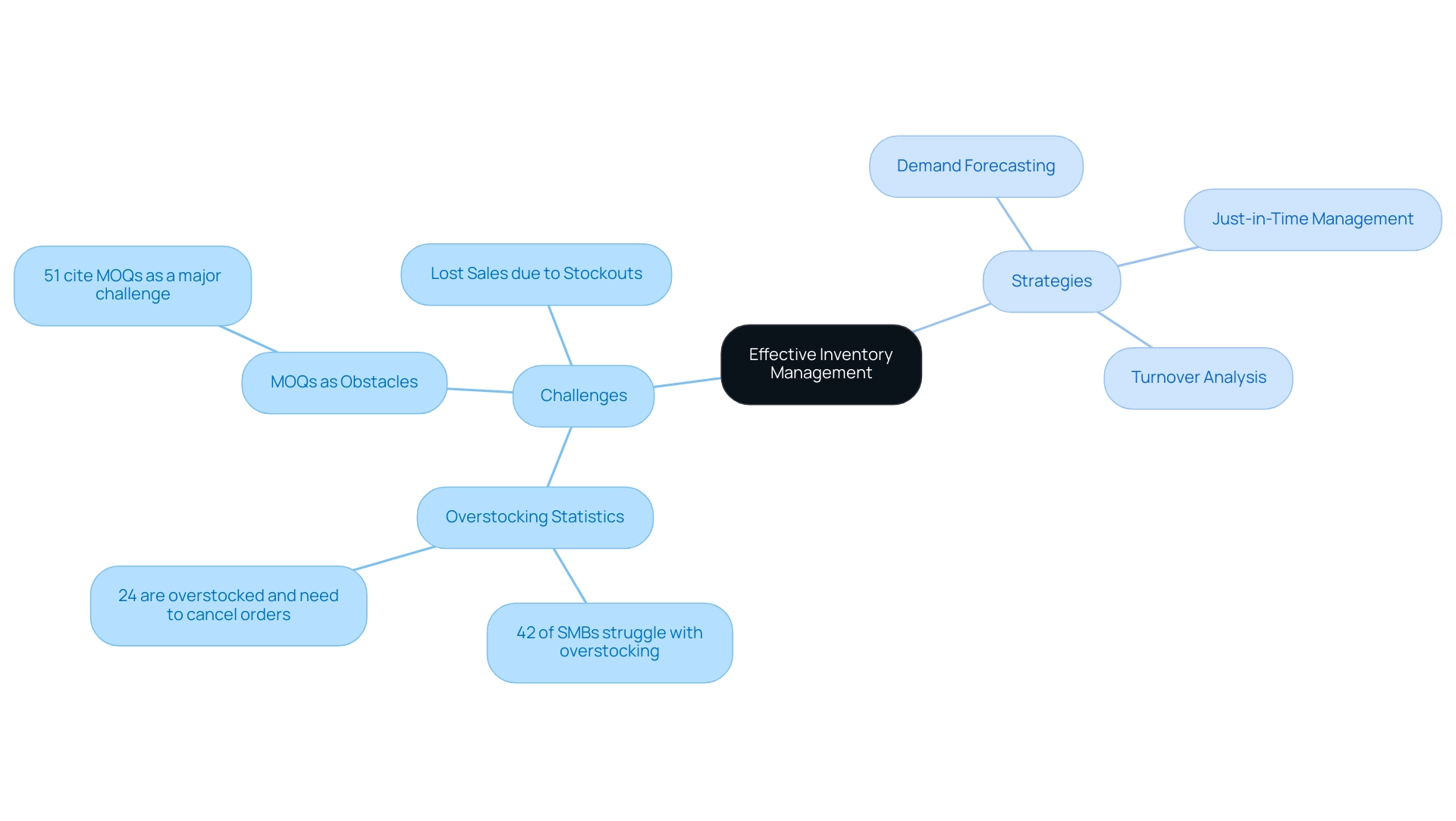
Challenges in Managing Inventory as an Asset
Handling stock efficiently as an organizational resource poses numerous challenges, especially in 2024. A notable 33% of U.S. small enterprises are still struggling with logistics delays arising from global disruptions. This situation complicates the ability to monitor stock levels precisely, as companies face the dual issues of surplus goods, which incurs increased holding costs, and shortages that can lead to lost sales opportunities.
FounderJar highlights a concerning statistic: only 22% of organizations have a proactive supply chain network, which exacerbates these challenges. To navigate these complexities, small enterprises should prioritize early investment in cost-effective or cloud-based stock control solutions. The need for stock control software has more than doubled in the last five years, yet only 22% of small enterprises currently utilize it, indicating a considerable chance for enhancement.
Additionally, incorporating technology and data analytics into stock management remains daunting for many businesses. Recent surveys reveal that respondents see potential for AI in:
- Forecasting (52%)
- Stock optimization (48%)
- Demand planning (44%)
Recognizing the impact of fluctuating demand and ongoing supply chain disruptions is crucial.
Adopting creative stock control solutions will not only reduce risks but also improve operational efficiency, ultimately resulting in better stock handling practices.
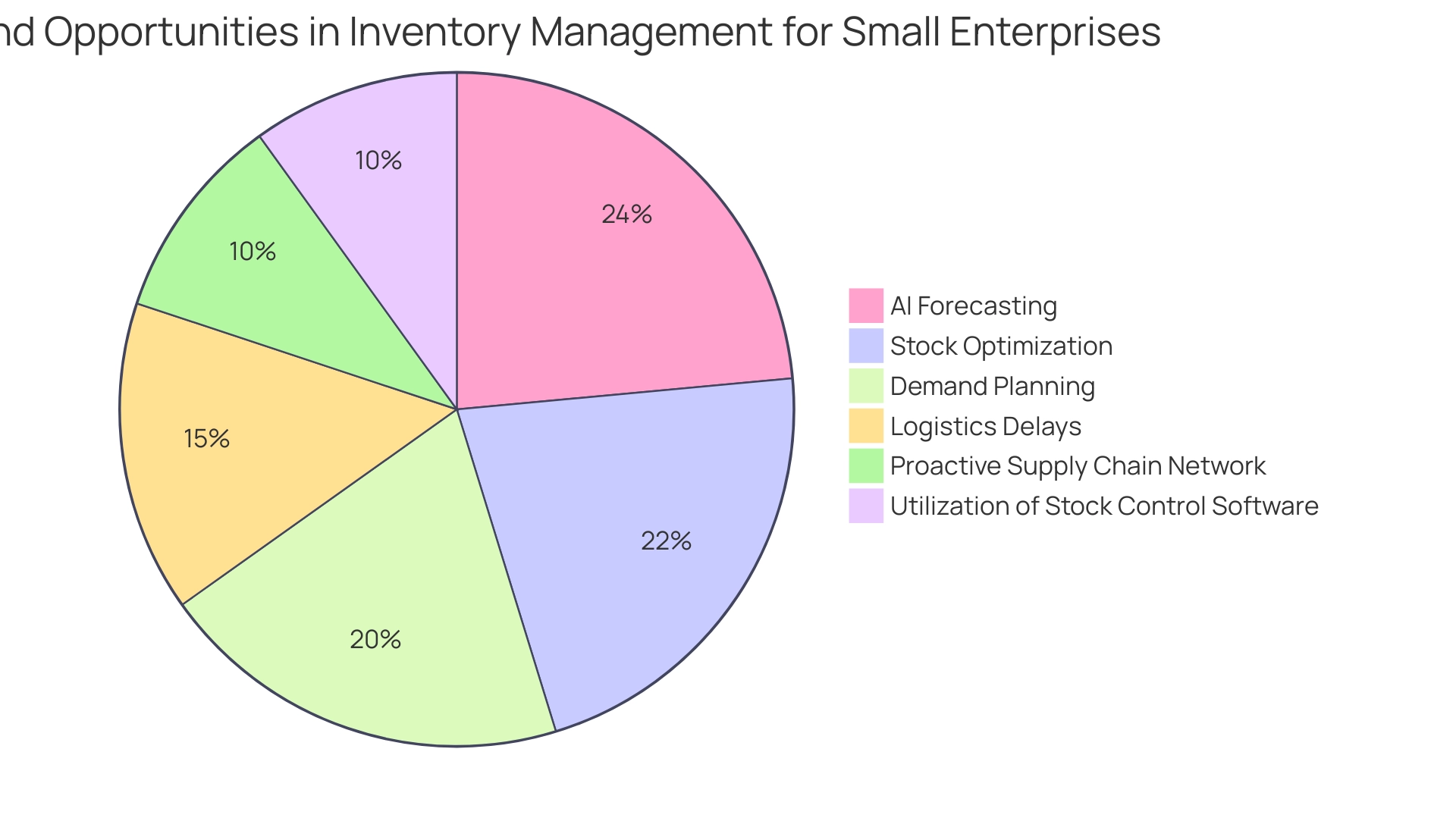
Best Practices for Optimizing Inventory Management
To effectively enhance stock management, small businesses should consider whether inventory is an asset and embrace several best practices that are crucial for success in 2024. Regular stock audits play a pivotal role, ensuring accurate records and enabling the early identification of discrepancies. This proactive approach is crucial, particularly in light of the findings from the case study ‘The Excess Problem,’ which shows that over half of SMBs reporting surplus stock attribute this issue to minimum order quantities (MOQs) set by suppliers.
The challenges presented by MOQs emphasize the necessity for improved stock control practices. Employing stock control software is another key strategy, as it streamlines processes and offers real-time insights into levels and sales trends, which raises the important question: is inventory an asset? Ritesh Kewlani, Head of Product Marketing, underscores that effective stock control is the backbone of eCommerce success, directly influencing profits and customer satisfaction.
Moreover, it is essential to recognize that only 22% of organizations currently possess a proactive supply chain network, which raises the question of whether inventory is an asset, highlighting the necessity for companies to adopt best practices in stock management, particularly considering the challenges revealed by the pandemic. Additionally, integrating a robust forecasting system allows businesses to anticipate demand effectively and adjust inventory levels accordingly, reducing the likelihood of overstocking, which currently affects 25% of manufacturing and 26% of retail trade in North America. By implementing these best practices, companies can significantly improve efficiency, lower operational costs, and enhance their overall performance in a competitive market.
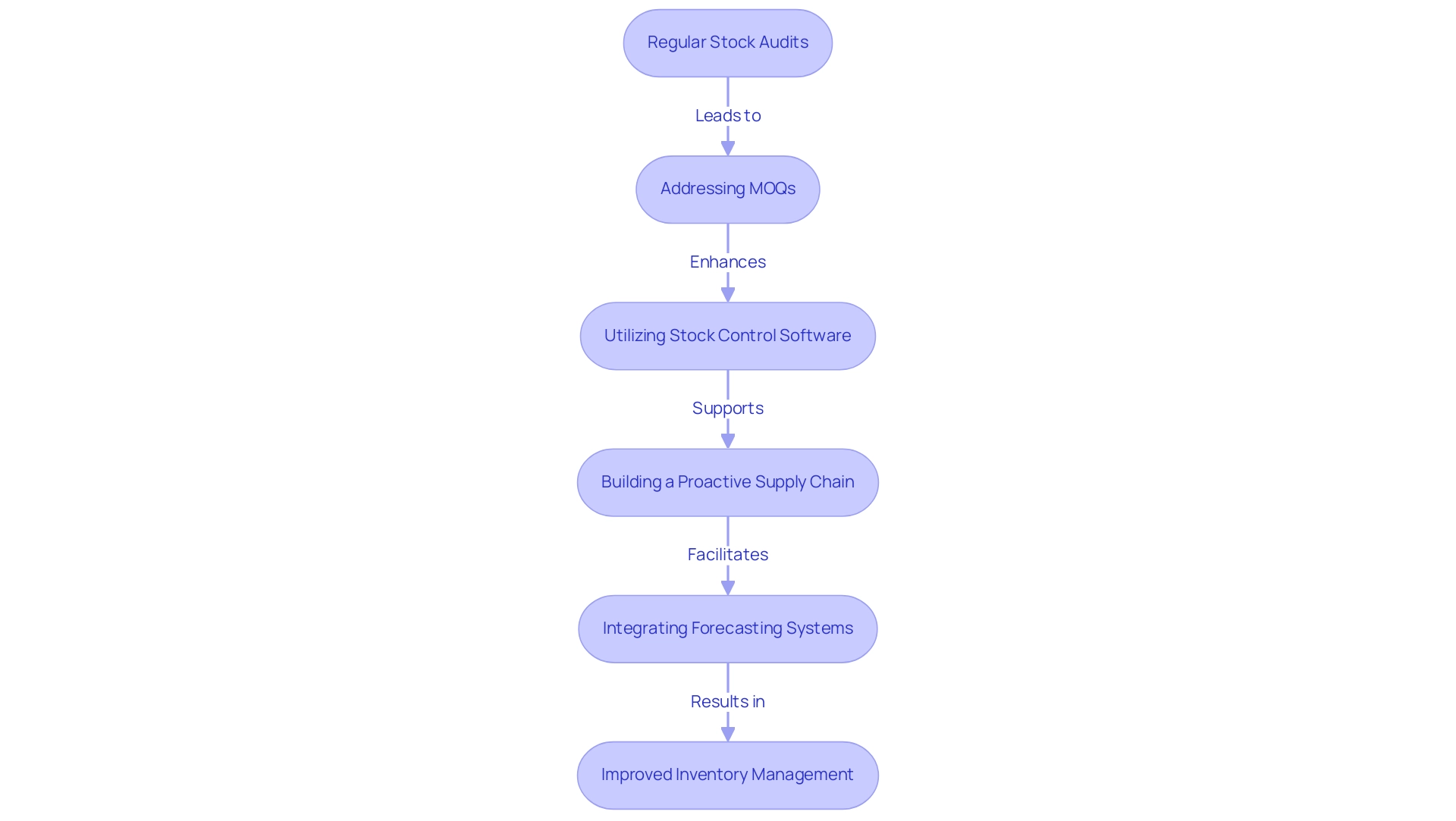
Conclusion
Effective inventory management stands as a cornerstone of business success, particularly in today’s rapidly changing market landscape. By understanding the various types of inventory, including:
- Raw materials
- Work-in-progress
- Finished goods
- MRO supplies
businesses can tailor their strategies to optimize cash flow and enhance operational efficiency. Recognizing inventory as a valuable asset not only impacts financial performance but also influences customer satisfaction and overall profitability.
Despite the challenges posed by supply chain disruptions and the complexities of managing inventory levels, implementing best practices such as:
- Regular audits
- Utilizing advanced inventory management software
- Embracing data-driven forecasting
can lead to significant improvements. The statistics reveal that a substantial number of businesses still grapple with issues related to overstocking and stockouts, underscoring the need for proactive measures.
Ultimately, the integration of technology and innovative solutions in inventory management is not just beneficial; it is essential for navigating the complexities of the modern business environment. Companies that prioritize effective inventory strategies will not only mitigate risks but also position themselves for sustainable growth and success in an increasingly competitive market. Embracing these practices today will pave the way for a more resilient and efficient operation tomorrow.
Frequently Asked Questions
What is the classification of inventory as a current asset?
Inventory is classified as a current asset on the balance sheet, representing goods and materials held for resale or production, with the expectation of converting them into cash within a year.
Why is understanding inventory as an asset important for businesses?
Understanding inventory as an asset is crucial because it directly impacts cash flow, profitability, and operational efficiency, which are vital for revenue generation.
What challenges do companies face regarding inventory management?
Companies must balance maintaining sufficient stock to meet customer demand while minimizing holding costs. Excessive stock can strain cash flow, while insufficient stock may lead to missed sales opportunities.
What recent trends are emerging in inventory management for small and medium enterprises (SMEs)?
SMEs are poised for rapid growth in resource handling solutions, promoting a more strategic approach to asset oversight and operational success.
What financial implications are associated with stock control?
Efficient stock control can significantly impact financial performance, as highlighted by a 10.1% increase in global warehousing property expenses in 2023.
What is the significance of logistics visibility in inventory management?
A case study shows that 79% of supply chain leaders use dashboards for visibility, and real-time tracking is a solution for visibility issues, although only a quarter currently utilize it.
What are the specific categories of inventory that small enterprises should manage?
Small enterprises should manage raw materials, work-in-progress (WIP), finished products, and maintenance, repair, and operations (MRO) resources.
How do the different categories of inventory impact business operations?
Each category has distinct implications for cash flow, storage needs, and operational effectiveness, and understanding these distinctions helps optimize stock strategies.
What percentage of organizations have a proactive supply chain network?
Only 22% of organizations have a proactive supply chain network, highlighting the need for strategic stock management.
What is the projected market growth for inventory management from 2025 to 2032?
The market is projected to grow at a CAGR of 9.6% from 2025 to 2032, emphasizing the importance of utilizing cloud-based management software for transparency and strategic decision-making.


